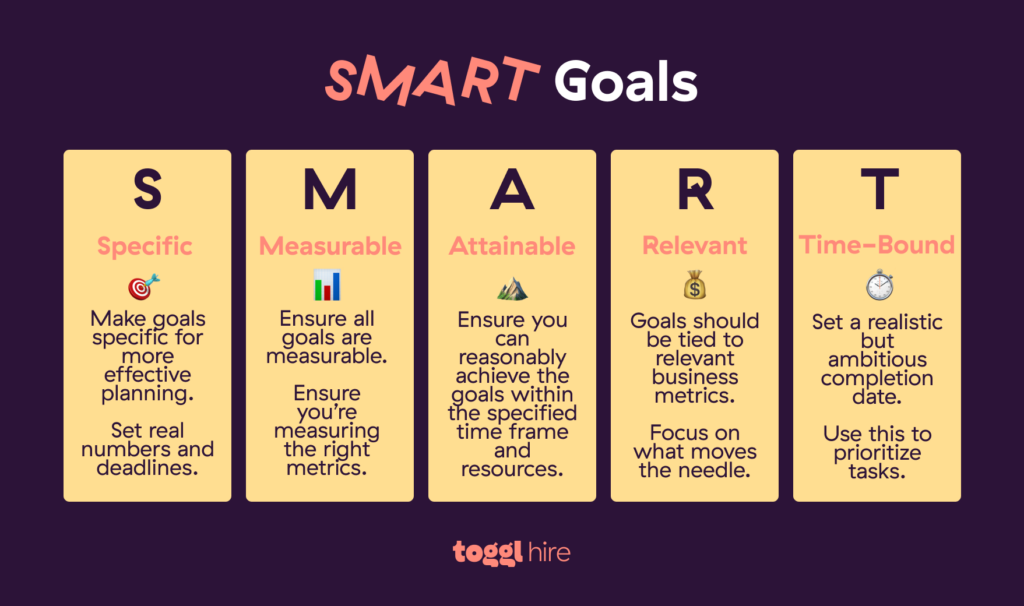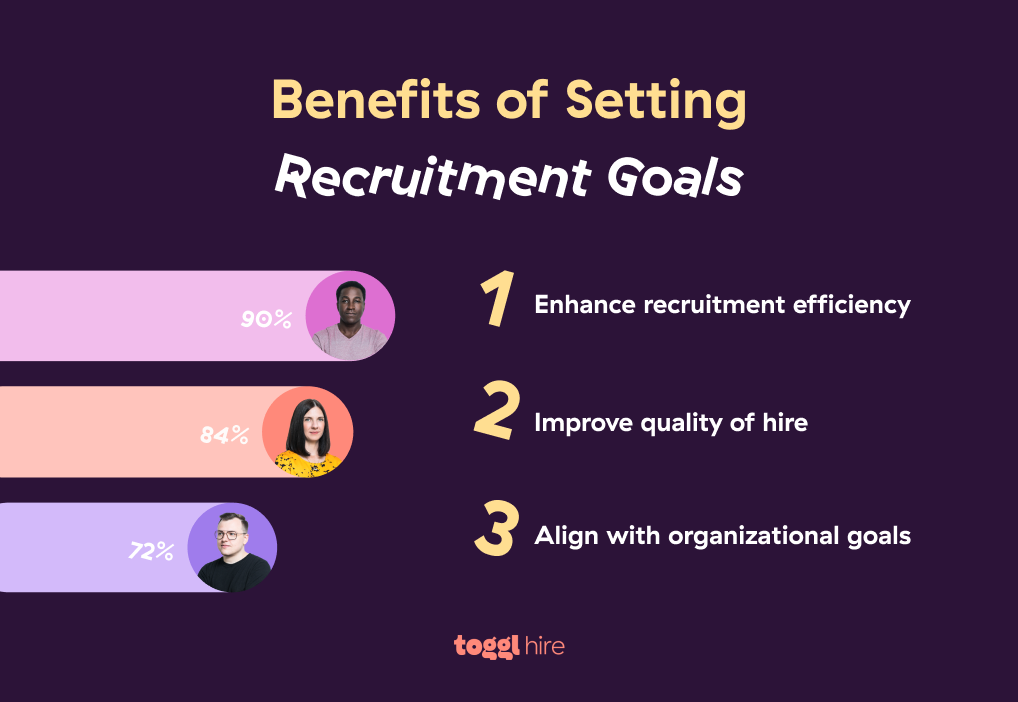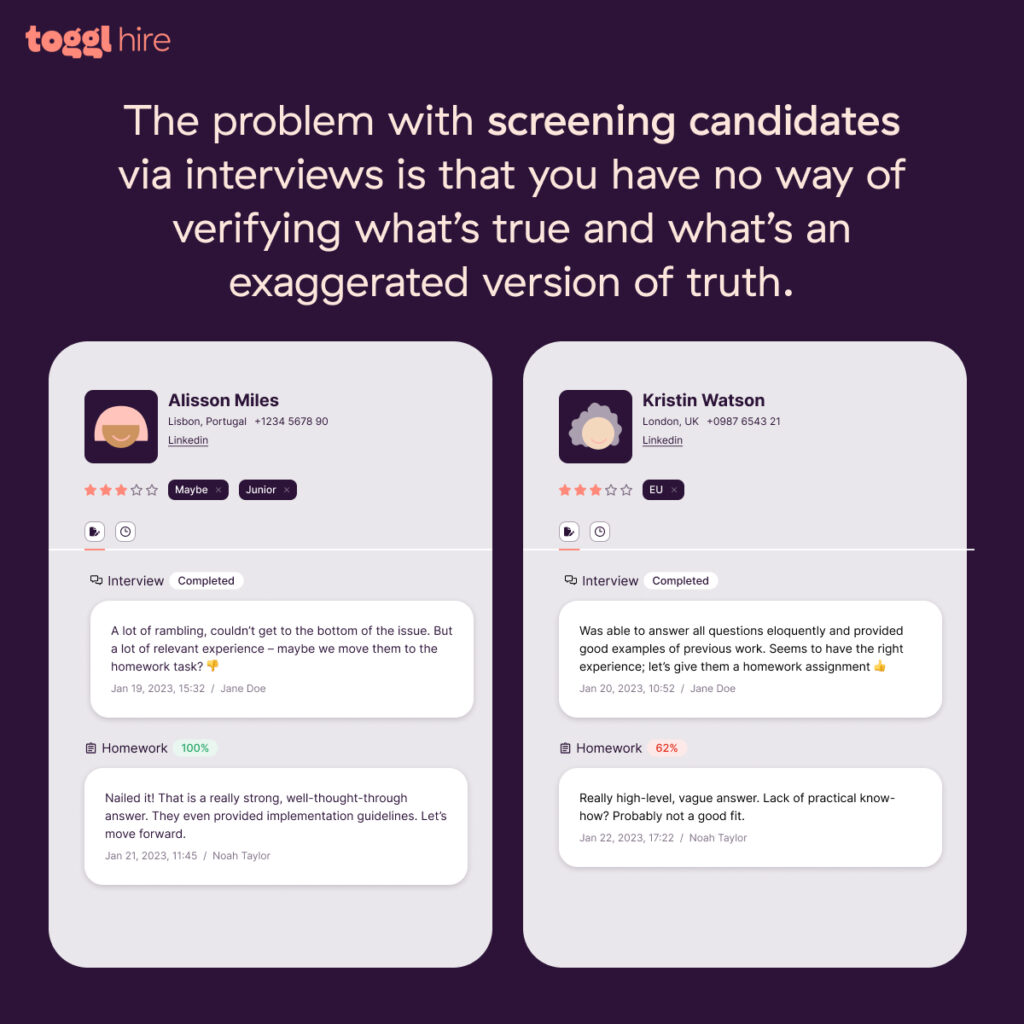It’s not a stretch to say that working in recruitment is tough right now. With the rise of artificial intelligence, the remote work debate, and continued labor shortages, finding, hiring, and retaining great talent is a challenge many companies face.
While there’s (unfortunately) not one simple fix, setting recruitment goals is a key part of organizing and optimizing hiring processes to overcome these common challenges with the least friction possible.
If done right, your goals won’t just help you find great hires, they’ll also help your hiring team improve your recruitment marketing efforts and recruitment metrics across the board — including reducing hiring costs, improving your employer brand, and more.
To get you started on the right path, we’ve put together a guide of ten smart goals your recruitment team should reflect on to make your process shine in 2024.
TL;DR — Key Takeaways
Recruitment goals are measurable objectives recruiters have to ensure they’re supporting the wider business goals in an optimized and efficient way. They usually follow the SMART method, meaning they’re Specific, Measurable, Achievable, Relevant, and Time-Bound.
Setting recruitment objectives ensures the whole hiring team works together with common objectives in mind. Smart goals enable you to track progress, see where you’re doing well, and where you might have room for improvement.
Key metrics to have in mind when developing your recruitment goals include candidate experience, cost per hire, time-to-hire, candidate sourcing, employer branding, diversity, quality of hire, skills, and reducing turnover.
It’s a great idea to leverage technology to streamline the process and make it as short and efficient as possible. This is great for developing a strong employer brand, but it can also help you save time and easily identify highly qualified job seekers (especially if you’re working with a larger talent pool or are constantly filling positions).
What are recruitment goals?
Recruitment goals are measurable objectives recruiters have to ensure their efforts are supporting company growth in an optimized and efficient way. These goals also ensure the evolving skills and human resource needs of the company are met.
These goals can be tied to any part of the process, from the recruitment marketing strategy to the onboarding process. They can also be granular and role-specific or take into account the funnel as a whole.
In any case, they tend to be SMART goals, as illustrated below.

Specific
Your goals should be super clear and detailed. It should be obvious to an external observer what you’re aiming for, so there’s no room for ambiguity. For hiring managers, this could mean sourcing 500 candidates for a new open role or reducing overall time-to-hire by 15%.
Measurable
What you don’t measure, you can’t improve. Your goals should be accompanied by trackable recruiting metrics, preferably bound to a numeric value wherever possible. This helps you see how much progress you’re making and what areas need attention. For example, recruiters might focus on reducing recruitment costs or improving candidate experience scores.
Achievable
Nothing undermines a team quicker than setting unattainable goals. Not only does this lead to individual self-doubt, it also lowers team morale. So, when setting goals, it’s important to tie them to data. If your candidate satisfaction score has been rising by 3% per month, don’t expect a 10% spike out of the blue. Also, consider the resources you have and any constraints that might limit your success.
Relevant
It’s important for hiring managers to be aware of the company’s strategic direction and how their roles ultimately serve it. Reverse-engineering specific goals from the wider mission is a failsafe way to ensure they’re relevant. That way, you’re sure all your individual goals are pushing your team in the same direction.
Time-bound
Time-based goals help teams prioritize the most important actions. They also help plan the longer-term strategic vision by knowing what goals are being pursued, when, and how they relate to each other. For all the goals you’ve written down so far, add “by [date]” at the end of them. For example, earlier, we mentioned reducing overall time-to-hire by 15%. Turn this into “reducing overall time-to-hire by 15% by the end of Q2.”
Why it’s important to set recruitment goals
80% of employee turnover is due to bad hiring decisions, and replacing an employee can cost 6-9 months of the employee’s salary. Keeping your hiring strategy short and sweet (guided by razor-sharp recruitment goals) can push your candidate experience scores into the 80s and 90s.
However, that’s not the only positive effect of setting recruitment goals. As with any type of business goal, setting a standard for success helps teams measure their efforts against outcomes. They force teams to identify where they’re falling short of business objectives and how they can make more successful hires.
Enhancing recruitment efficiency
Setting specific talent acquisition goals brings clarity to the day-to-day of the job and helps individual employees understand their objectives. This helps everybody see how they can use resources more effectively, ultimately resulting in a reduced time to hire and improved internal processes.
Improving the quality of hire
Recruitment goals that focus on procuring higher quality applicants lead to better job-candidate matches, reduced turnover rate, and better overall job satisfaction. These ultimately contribute to the organization’s success by creating more cohesive and motivated teams.
Aligning with organizational objectives
If you want a successful recruiting strategy, your goals and objectives must align with the broader vision of the organization. This ensures a cohesive approach with a unified direction and purpose. Some great ways to implement this are through regular reviews or strategy-level meetings between recruiters and the leadership team of any given department.

10 smart recruitment goals to aim for in 2024
Is it clear by now — that it’s important to set recruitment goals that align with the company’s long-term objectives and actual needs? Great! Now…where do you get started in setting your own goals and key performance indicators?
We’ve made a list of ten goals below to get you started, but you’ll likely need to customize them to suit your needs. Factor in your budget constraints, timelines, growth goals, and skill needs when doing so, and you’ll be well on your way to a personalized and smart recruitment strategy.
1. Speed up the hiring process
65% of hiring managers reported losing out on top talent because of a long hiring process. These days, it’s safe to say that the best job seekers will not wait around for you to decide if you want them or not. They’ve already said yes to that other company who got back to them with an offer ASAP.
If you want to stay competitive and attract top talent, you have to streamline and speed up your hiring process as much as possible. You ideally want the entire candidate journey to last between two to four weeks from initial contact.
Don’t panic — with the right tools, this is totally achievable. To start, set clear timeline goals with your talent acquisition team. Then, support them with automated screening tools or video interview software that allows you to objectively and asynchronously evaluate candidates.
2. Enhance your employer branding
Your employer brand is a megaphone that attracts prospective employees interested in aligning with your company culture and vision. So, get clear on what your company culture is and who you’re trying to attract with it. Once you’re clear on that, highlight that in all your job descriptions.
If you’re coming off as messy, indecisive, uncommunicative, and unsure of what you want or need from a potential employee — I’m sorry to tell you that’s probably why you’re candidates are giving you that vibe back.
To fix this, start by showcasing your company culture, values, and employee testimonials on your website and social media platforms. You want job seekers to feel like they “get” what it feels like to be in your club before they even join. That way, the ones who will fit right in will naturally resonate with you and apply.

3. Improve the quality of hire
Doubling down on quality candidates will pay dividends in the long run, mostly in the form of increased productivity and lower employee turnover. So, how do you attract top talent? Well, we can tell you how talent acquisition works here at Toggl.
We start with a thorough job description infused with personality. We want to paint a picture of what day-to-day responsibilities a candidate can expect while also showing off our unique company voice. Don’t be afraid to infuse a little personality into your job ads. After all, if you’re a young start-up making children’s toys, why does your job description sound like you’re Deloitte?
Next, we use skills tests to instantly shortlist the most qualified candidates for the position. We then (usually) follow this up with 1-2 structured interviews to get a feel for candidates’ past experiences and communication styles. If you keep track of successful candidates long enough, the data analytics will start to reveal predictive indicators of candidate success, optimizing your process over time.
4. Focus more on skills (not resumes)
We live in the era of Coursera and the gig economy. Anyone can gain proficiency in a skill these days, even without formal work experience. It would be doing a great disservice to your potential candidates to lend more weight to their resumes than those skills.
Skills-based hiring can reveal hidden talents, give someone their “big break” into formal work in the field, and promote a more diverse and capable workforce.
Use skills tests at the start of your hiring process to weed out unqualified candidates and longer, more specific skills tests (or homework assignments) towards the end of the process to truly identify the top performer to be your new hire.

5. Diversify your candidate pipeline
We wholeheartedly believe that a diverse workforce is a necessity for innovation and growth. Diverse teams are better decision-makers, leaders, and creative thinkers than less diverse teams, so your talent pipeline mustn’t become an echo chamber of the same type of person.
You can avoid this by broadening the channels on which you share job postings, partnering with diversity-focused organizations, and auditing job descriptions for exclusionary language to ensure you’re not unknowingly putting off certain groups from applying.
6. Build an employer referral program
A shortcut to a great hire is through an employee referral program. Of course, there are always exceptions, but generally speaking, referrals are much faster to hire and are better cultural fits.
If you decide to establish such a program, you must first get super clear on why. Is it to foster a more cohesive team? To reduce your time-to-hire? To save money on recruitment? Is an employee referral program the best way to accomplish those goals, or do other areas need your attention instead?
Once you decide to move forward with the program, ensure it has very clear guidelines, attractive incentives, and regular communication about open positions with employees.
7. Improve the candidate experience
Take a moment and put yourself in your candidate’s shoes. If you had to go through your own hiring process, would you enjoy it? If not, it’s time to make some changes.
You know what they say: the way you do one thing is the way you do everything. If your candidate’s experience in the recruiting process sucks, why wouldn’t the candidate think your internal processes also suck?
Indeed, 50% of candidates reject a job offer due to a poor hiring experience. And candidates talk. 72% of candidates report sharing negative experiences online, meaning it’s make-or-break for your employer brand.
Some quick wins to put you in candidates’ good books include simplifying the application process, timely communication, and providing constructive feedback to unsuccessful candidates.

8. Reduce your cost per hire
Any recruiter worth their salt will have their finger on the pulse of their cost per hire. A north-star metric, this number is ideally always trending slightly downwards. But how do you reduce these costs without sacrificing the quality of your candidates and hires?
This is a two-part solution. Part one involves getting more of the right kind of people into your hiring funnel. So, you could optimize job ad placements by leaning into niche job boards. You can also leverage network effects by asking your existing employees to reshare job openings on their social platforms. It’s also worth ensuring your job descriptions clearly communicate expectations.
Part two involves optimizing every stage of the hiring funnel to limit drop-offs. Part of achieving this goal is having your ideal candidate profile nailed down, and part of it is crafting a recruitment process with intention, style, good benefits packages, and a touch of urgency.
9. Minimize employee turnover
Who was it who said you gotta start with the end in mind? Whoever said it, it’s true for your recruitment success, too.
Hiring with employee retention in mind can save costs and maintain team morale. You can do this by focusing on cultural fit, providing clear career progression paths, and implementing regular check-ins with new hires to make sure they’re satisfied and engaged in their work.
Another great move is to be as transparent as possible in the interview process about flexible working arrangements and benefits. It’s better to manage expectations upfront and lose a leading candidate than to hire someone who quits three months later because the setup isn’t what they expected.
10. Simplify the recruiting process
What do recruitment and going to the doctor have in common? An annual physical is always a good idea. Do a yearly audit of your entire hiring process. Use this as an opportunity to streamline your recruitment tech stack, revise the budget, and eliminate unnecessary complexities, both internal and external.
Take a step back and put the candidate in the center of it all. Are the recruiting software tools you’re using helping or hindering efficiency? Are you still offering competitive compensation? What feedback has repeatedly come in from candidates about the overall process? Are they getting all the info they need in a timely manner and at every stage?

Use Toggl Hire to improve your recruitment process
Recruitment is the engine that fuels the company with its most important asset — its people. There are tons of innovative tools out there you can leverage to help streamline hiring and enhance the candidate’s experience, depending on what specific areas of the process you need support with.
With Toggl Hire, you can easily:
✅ Automate the initial screening and evaluation stages
✅ Prioritize skills over resumes
✅ Simplify the hiring process for candidates
✅ Make data-driven decisions throughout the recruitment process
✅ Improve fair hiring practices
Create a free account to see how you can use our candidate management, matching, and pipeline features alongside skills testing to achieve your recruitment goals this year!
Julia is a freelance writer and fierce remote work advocate. While traveling full-time, she writes about the intersection of technology and productivity, the future of work, and more. Outside work, you can find her hiking, dancing, or reading in a coffee shop.




